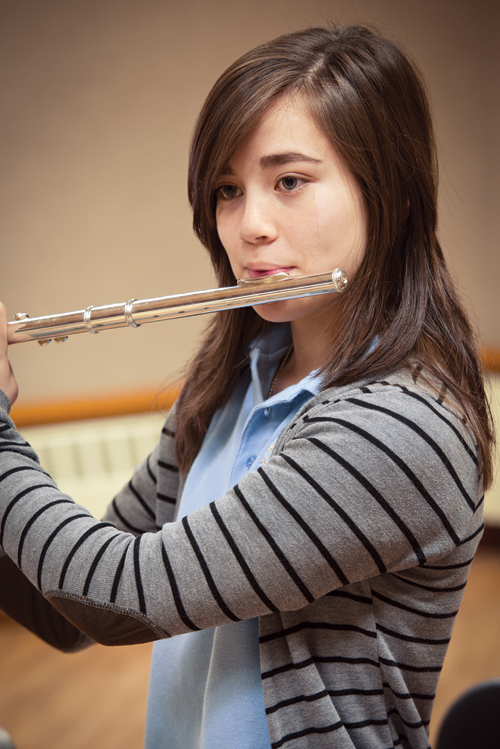
Even when I began my piano studies at five years old, I loved to play fast. I loved to play fast better than playing musically. On one of my first recitals, I was to perform Chopin, Op. 28, Nos. 7 and 20. I began with No. 7, the delightful A major waltz and all was well. Then I played No. 20 in C minor, which is the famous 13-measure funeral march. For some reason I took off on the funeral march at lightning speed. For a piece that should have lasted for at least a minute and a half, it was over in a flash. As I stood to bow, I heard a voice from the back of the hall saying, “Could you play that again and slow down?” I had no idea that I had rushed through the piece. The notes had flowed through my brain with such ease. It felt good because I loved to play fast. Reluctantly I returned to the piano bench and with all the concentration a child of six could muster, I painstakingly played the march again at a snail’s pace with exaggerated dynamics.
I have some limited experience in teaching piano and often had students who could and did play fast. However, I find that fewer young flute students play fast. Perhaps this occurs because young flutists learn in an ensemble setting, and most of their playing is controlled by a conductor’s beat. Another factor may be that it takes only one finger to make a note on the piano while on the flute it can take as many as nine.
As flutists progress and gain control of the various fingering patterns, many students eventually do begin to play quickly. However, there are legions of flutists who continue to plod along, playing everything slowly and methodically as if they did not want to make a mistake.
Theoretical Foundation
Flutists who can play fast have a thorough knowledge of scales, scales in thirds and sixths, arpeggios, and seventh chords (arpeggiated and broken). They see four-beamed notes in intervallic and scale patterns such as 1234, 1324, 1321, 1432, 4321, and 4231. They are equally practiced in all the keys. When learning etudes, they read by scale patterns. Chordal passages are identified by quality (major, minor, diminished, or augmented) and key. Students who continually play slowly read note-by-note, failing to see the patterns in music. Teachers should guide students through the process of becoming good readers in preparation for the day when they will play fast. Often teachers make metronome markings in the music to encourage a steady increase in tempo for practice during the week. Sometimes it works and sometimes it does not.
A Breakthrough
A few years ago I had a university flute student who played unusually quickly. Everything she brought into the lesson was played in tempo; often even a bit too fast. However, everything she played was technically clean and musical. At the end of the term I assigned several Paganini Caprices to learn over summer break. When she came back in the fall, she had learned all 24. My first thought was wondering what was the quality going to be like, but to my surprise it was excellent.
Good teachers know they can learn as much from the students as the students can learn from them. So, I asked her how she played so fast. She thought for a moment and said, “When I was in middle school, whenever we learned something new, my band director had playing tests to see who could play it the fastest. I liked to win.” She had learned to play fast by playing fast. What a novel idea.
At the time I was assigning the Luigi Hugues, 40 Studies, Op. 101 as chunking material. With this technique, a flutist plays one inch of notes followed by a rest, repeating the process throughout the exercise. Since the eye takes in information in one inch chunks in about a quarter of second, I was retraining how flutists read music. With the insight I had gained from my fast-playing student, I added a new instruction to play each chunk as fast as you can on one blow of air. The one blow of air is important because plodders often count each note with a pulse in the air stream. Recall how many beginning bands put a breath accent on each note of the song. To play fast and musically, grouping of notes should be played on one blow of air.
After a few weeks of playing each chunk as fast as they could, I noticed that other students in the studio were beginning to play fast. The bottom line is: If you want to play fast, you have to practice playing fast. Simple.
Additional Thoughts
In order to play fast, flutists should have a good hand position with the flute well-balanced in the hands. Each finger should be able to move up and down moving only the key(s) and not the entire flute. The flute should be stable in the chin and balanced equally in the hands. However, if a difficult fingering is in the right hand, switching the balance a slight bit to the left hand, makes the right fingers feel light and agile. Flutists shift this balance regularly when going from C5 to D6 or C#5 to D6.
Because of the nature of beginning band method books, which are designed to teach a variety of instruments together in one class, flutists are rarely required to play fast. As soon as a new note is introduced, the teacher should broaden the curriculum to have the flutes practice trilling from the new note to an adjacent note to keep the fingers light. For example, if flutists learn B5 and then C6, trill from B5 to C6. If the next note introduced is an A5, then trill from an A5 to a B5. Then add the tremolo from A5 to C6. Teaching a variety of these fingering combinations early on will help flutists learn not to clutch the flute and to keep it balanced. More advanced flutists can trill or tremolo between each two notes of an etude. Playing fast, slurred tremolos is also good for developing embouchure flexibility.
After a day of teaching beginning and intermediate students, I find that I have played slowly for too much of the day. My fingers feel heavy and there is little sparkle in my playing. So, the first thing I do is play fast. Sometimes I play a round of trills, the Swing exercise, some scales, or chunk a book of etudes. Immediately my fingers begin to feel light and agile and my breathing is better coordinated with my fingers. Then I am ready for a traditional practice session.
* * *
The Swing
Playing fast can happen when a flutist has some degree of expectation of what note is coming next. This is why scale (diatonic and chromatic) and arpeggio study are important. The following exercise is an excellent one for beginning students as it teaches which finger comes next in a scale sequence. While I made this exercise up for beginning students, it is an excellent warmup for advanced performers as well. Besides the obvious goal of teaching which note comes next, advanced performers can work on playing more and more notes on one blow or puff of air.
Play each group ten times on one blow of air at a fast speed.

.jpg)
Play this line many times.

Many honor band’s audition rules require flutists to play a three-octave scale slurred from C4 to C7 ascending and descending on one breath. Most students can do this fairly well after they conquer the first two notes C4 and C#4. The problem with these notes is most flutists move slightly forward as they start this scale; however, the right hand little finger moves to the back from the C to the C#. Having students begin the scale by moving back ever so slightly for C4 and C#4 and then begin moving forward on the D4 will solve this problem.






